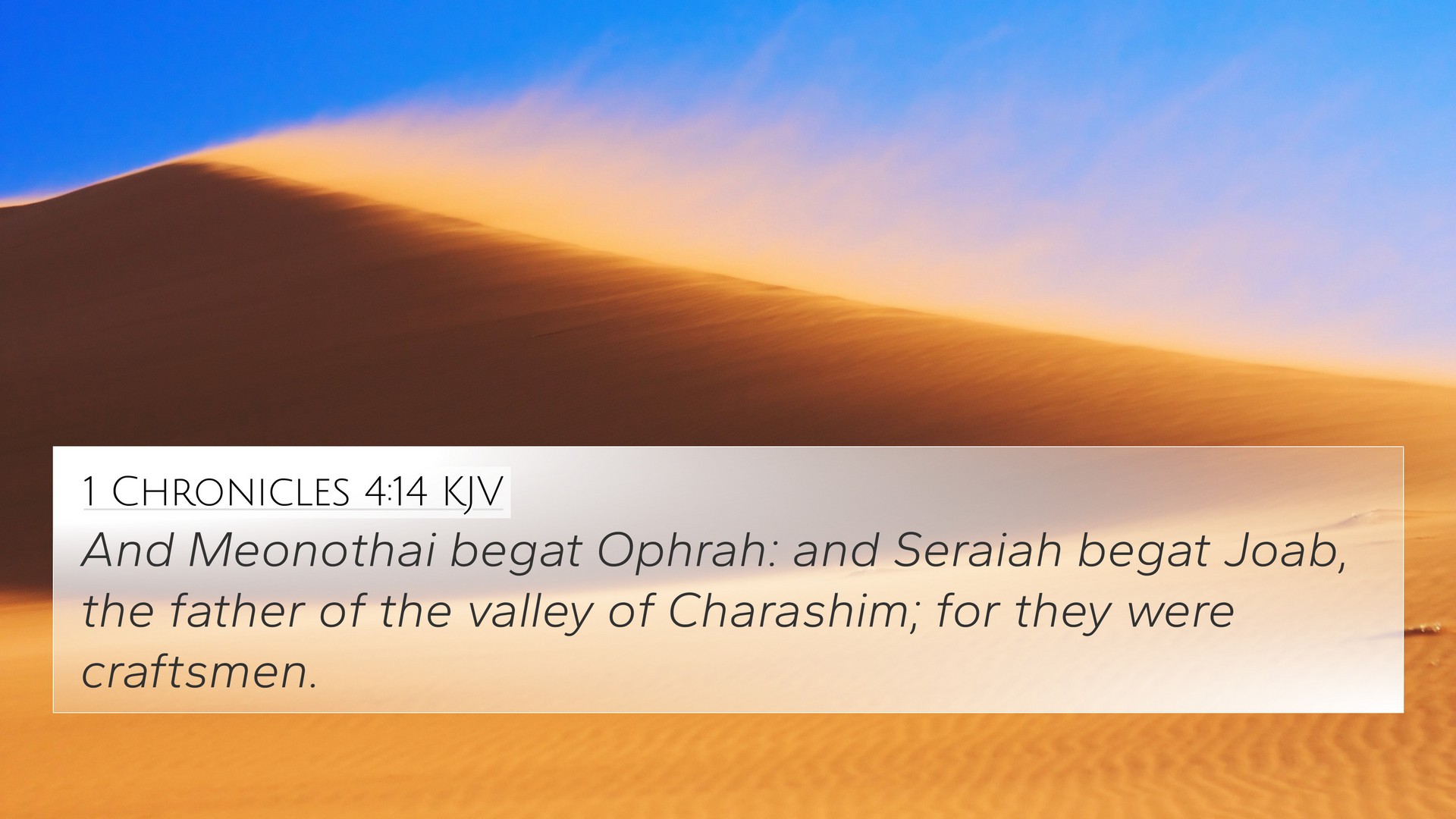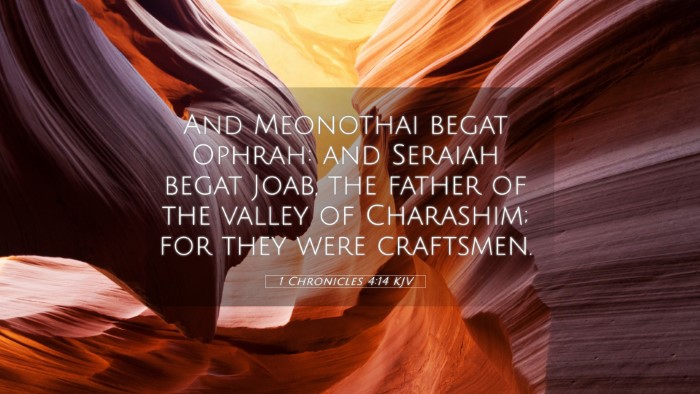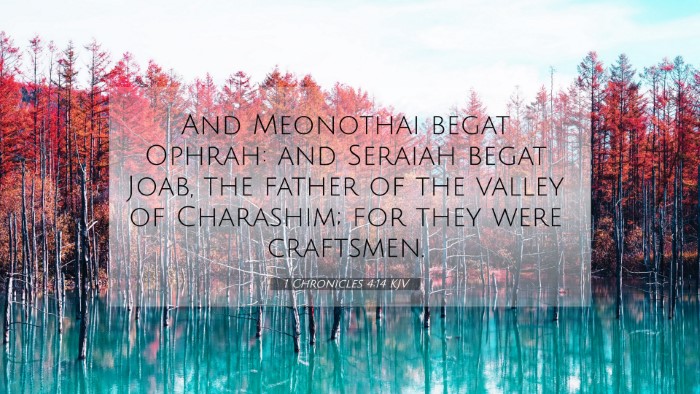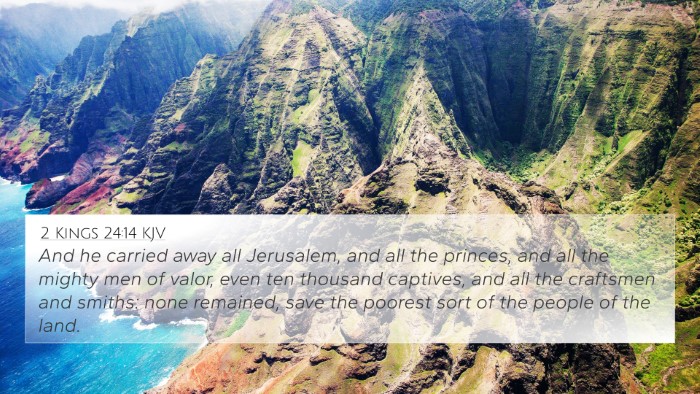Bible Verse Meaning: 1 Chronicles 4:14
Verse: "And Mehir was the father of Eshton. And Eshton begat Bethrapha, and Paseah, and Tehinnah the father of the city of Nahash. These are the men of Recah." (1 Chronicles 4:14, KJV)
Summary of 1 Chronicles 4:14
This verse gives a brief genealogical account of some descendants of Judah. It highlights Mehir and his son Eshton, followed by Eshton’s children and their notable city, Nahash. This genealogy is part of a larger section that seeks to record the lineage and territories arising from the tribe of Judah.
Commentary Insights
Matthew Henry's Commentary
According to Matthew Henry, this verse, like many genealogies in the Bible, emphasizes the importance of familial lineage in biblical history. It demonstrates God’s plan working through families and individuals. The mention of cities and fathers reflects the way biblical societies valued roots and heritage, linking them to their past and God's covenant with His people.
Albert Barnes' Notes on the Bible
Albert Barnes notes that this verse illustrates the connections within the tribe of Judah, showcasing individuals who played significant roles in the establishment of cities and communities. It’s a reminder of God's faithfulness to His covenant, as seen through the continuation of families and their contributions to the nation of Israel.
Adam Clarke's Commentary
Adam Clarke points out that the detail in genealogies may seem tedious, yet they are vital for understanding the historical context of the Israelites. Clarke suggests that such passages link the Old Testament narrative to the New Testament's broader themes of redemption and fulfillment of God's promises, showing how the lineage leads to Christ.
Connections to Other Scriptures
1 Chronicles 4:14 connects with several other Bible verses, illustrating the interconnectedness of scripture:
- Genesis 46:12 - Lists the descendants of Judah, linking to the broader genealogical context.
- 1 Chronicles 2:4 - Offers insights into the tribe of Judah and its significance in Israel's history.
- Luke 3:33 - Traces the lineage of Jesus back to Judah, emphasizing the fulfillment of God's promise.
- Matthew 1:3 - Provides a genealogy that shows the importance of King David's lineage.
- Hebrews 7:14 - Highlights Jesus' priestly lineage, connecting back to Judah.
- Ruth 4:18-22 - Offers another genealogy involving Judah, linking family heritage to David's lineage.
- Revelation 5:5 - Refers to Jesus as the Lion of the Tribe of Judah, showing the ultimate fulfillment of lineage.
Thematic Connections
This verse's focus on genealogy invites further exploration of several themes:
- Heritage and Legacy: The importance of lineage in understanding God's plan (Psalms 78:1-7).
- God’s Faithfulness: How God’s promises are fulfilled through generations (Deuteronomy 7:9).
- Community and Identity: The role of families in the identity of the Israelite community (Ephesians 2:19-22).
Understanding Genealogies in the Bible
Genealogies serve multiple purposes in scripture, including:
- Establishing legitimacy and claims to inheritance (Numbers 26:53-55).
- Providing historical context for the movement of God's plans (Acts 17:26).
- Drawing connections between the Old and New Testament themes (Romans 1:3).
Conclusion
The study of 1 Chronicles 4:14, enriched through the insights of public domain commentaries, reveals a nuanced understanding of biblical genealogies, their significance in God's covenant, and their connections to broader scriptural narratives. Each genealogy serves to connect the past with the future, highlighting God’s unchanging nature across generations.
Tools for Bible Cross-Referencing
For those seeking to delve into the depths of biblical genealogies and cross-referencing, consider utilizing the following resources:
- Bible Concordance: A tool to locate specific terms and their occurrences throughout scripture.
- Bible Cross-Reference Guide: A resource that provides direct relationships between verses.
- Bible Study Software: Programs designed to aid in cross-referencing and comparative study of scriptures.
Final Thoughts
Engaging with biblical texts through cross-referencing encourages a deeper understanding of the interconnectedness of the scriptures. This not only enriches personal study but also enhances understanding in communal settings, such as sermons or Bible study groups. Exploring the connections in 1 Chronicles 4:14 can lead to a more profound appreciation of God’s overarching narrative throughout the Bible.




